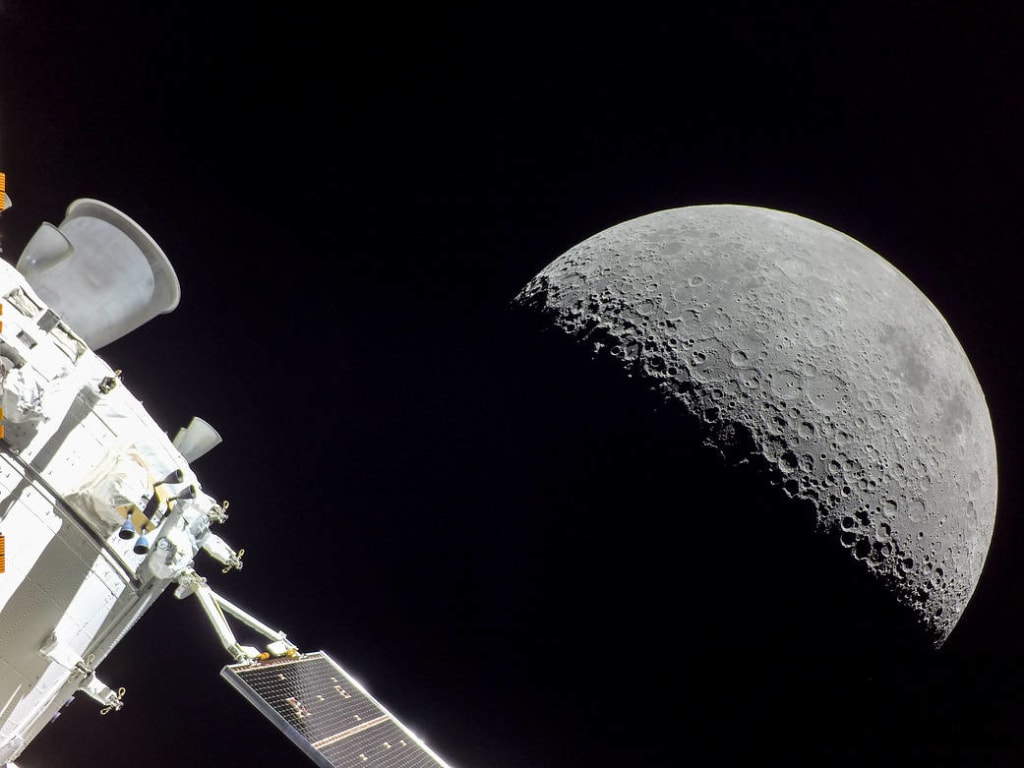ARTEMIS I ON ITS WAY BACK HOME
Artemis I is NASA’s ongoing, uncrewed test mission to the moon and back. Find out what the mission has accomplished so far, and about the plans for slashdown this Sunday, December 11.

Growing up during the Space Race, there was a final ritual to which we all looked forward. After an American space capsule carrying astronauts re-entered the atmosphere, it deployed its parachutes and landed in the Pacific Ocean.
An aircraft carrier would be waiting nearby, and helicopters would hover over the floating capsule to lift the astronauts from the ocean. Then, they’d ferry the astronauts back to the ship for the trip home.
Back in those days, when scientists weren’t sure if there was life on the moon, the astronauts would be quarantined for 21 days after a moon mission. They lived in a mobile quarantine facility which NASA could fly back to Houston for most of the lock-down.
RE-ENTRY AT LEAST AS DANGEROUS AS LIFT-OFF
Although it was less spectacular than lift-off, re-entry was at least as dangerous. The capsule returned to Earth without power, and it had to enter the atmosphere at precisely the correct angle to avoid bouncing back into space forever.
The friction of the atmosphere generated intense heat and flames. If the heat shield failed, the astronauts would die. That’s what happened in the space shuttle Columbia disaster.
NASA’s latest lunar mission, Artemis I is about to go through the same procedure. Its Orion space capsule will splash down near Guadalupe Island in the Pacific Ocean this Sunday.
SO FAR, COMPLETELY SUCCESSFUL UNCREWED TEST MISSION
So far, by all accounts, it’s been a completely successful, uncrewed test mission. The mission’s goal is to test as many systems as possible in real-life conditions before landing people on the moon again.
According to NASA, Project Artemis is “going to the moon for scientific discovery, economic benefits and inspiration for a new generation of explorers.” It’s part of an ongoing plan to use the moon as a springboard to a crewed mission to Mars.
The most intriguing aspects of the mission have been the Artemis I space capsule Orion’s close flybys of the moon. During the first maneuver, Orion was just 130 kilometres above the moon and at the same time, 370,000 kilometres from Earth.
TRAVELLED OVER APOLLO 11 LANDING SITE
During the flyby, Orion traveled over Apollo 11’s original landing site, as well as around the far side of the moon. Commenting on the flyby, Artemis I mission manager Mike Sarafin said, “The mission continues to proceed as we had planned, and the ground systems, our operations teams, and the Orion spacecraft continue to exceed expectations, and we continue to learn along the way about this new, deep-space spacecraft.”
Orion then started travelling beyond the moon, following a trajectory similar to the on the Apollo 13 crew used to slingshot their damaged spacecraft around the moon and back to Earth. In fact, Artemis I broke Apollo 13’s record for the furthest distance from Earth by a space capsule.
After reaching its maximum distance from Earth, Orion fired its main engine to leave lunar orbit with a maneuver called the distant retrograde departure burn. Then, following its slingshot strategy, it returned to the moon and made a second lunar flyby.
SPLASH DOWN IN PACIFIC PLANNED FOR SUNDAY DECEMBER 11
Having completed that flyby, Orion left the lunar sphere of influence for the final time and headed back to Earth. As I write this, the plan is for Orion to splash down in the Pacific on Sunday, December 11.
The command and service modules will separate, with only the command module re-entering the atmosphere. Orion will be trying a new kind of re-entry maneuver called a “skip entry.”
The technique is a bit like skipping stones across a pond. It makes re-entry more accurate, and allows spacecraft to splashdown closer to the US coast.
“SKIP RE-ENTRY” LIKE SKIPPING STONES ACROSS A POND
The capsule will dip into the outer atmosphere and back out again, followed by a final re-entry maneuver. The atmosphere will slow the capsule from its current cruising speed of 1,300 km/hr to 525 km/hr.
Landing closer to the coast will be an important safety improvement for crewed missions. It makes it easier to recover the astronauts and to deploy additional resources if needed in an emergency.
The Artemis I splashdown will be very much like the ones I remember from 50 years ago. The capsule will deploy its 11 parachutes and splash into the ocean, where naval crews will retrieve it.
NASA TO BROADCAST SPLASHDOWN STARTING AT 11 AM
NASA will broadcast the splashdown starting at 11 am EST on December 11. Orion will land in the ocean at around 12:40 pm.
I’ll be watching it, if only for nostalgia’s sake. Space travel has always provided scientific and economic benefits.
We’ll learn more about the moon and our solar system from crewed lunar landings in the future. Building the spacecraft fosters invention and technological innovation as well as creating employment.
REAL REASON FOR SPACE TRAVEL IS INSPIRATION
Even so, if we’re honest with ourselves, the real reason we devote so much time, effort and money to space missions like Artemis I is NASA’s third reason – inspiration. Humanity is insatiably curious and we all love a hero’s journey.
Even when our hero is a machine using artificial intelligence, we take pride in its accomplishments. We all want to know what’s out there, and whether we’re alone among the stars.
“At present, we are on track to have a fully successful mission with some bonus objectives that we’ve achieved along the way,” Mike Sarafin concluded. “On entry day, we will realize our priority one objective, which is to demonstrate the vehicle at lunar re-entry conditions, as well as our priority three objective, which is to retrieve the spacecraft.”
We always have more to learn if we dare to know.
Learn more:
Artemis I on Its Way to the Moon
DART Mission Demonstrates NASA’s Planetary Defense Strategy
James Webb Space Telescope Photos are Spectacular
About the Creator
David Morton Rintoul
I'm a freelance writer and commercial blogger, offering stories for those who find meaning in stories about our Universe, Nature and Humanity. We always have more to learn if we Dare to Know.






Comments
There are no comments for this story
Be the first to respond and start the conversation.